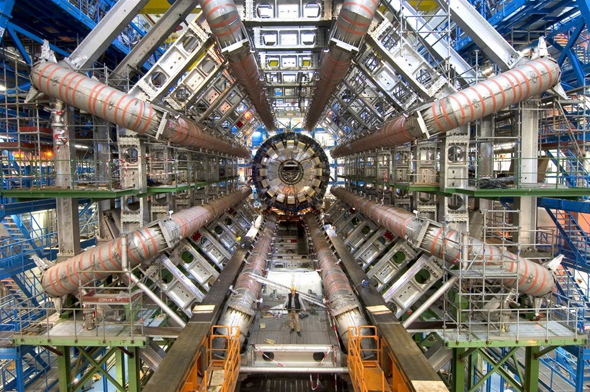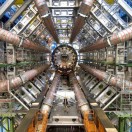
How did the universe come into being? What forces prompted the formation of stars, worlds, atmospheres, and ultimately, humans?
Physics is one of those disciplines that can and should be utterly fascinating, but the means of communicating it can render it opaque for many people. The mathematical language of physics is an obstructive foreign one for the layperson, and its higher concepts can seem unattainably complex. A physics teacher’s greatest challenge and achievement is not necessarily to teach the curriculum, but to instill students with an enthusiasm and curiosity for science that will last a lifetime. That also seems to be the mission of the new Anthos Media documentary from director Mark Levinson, Particle Fever.
The documentary follows the work of some theoretical and experimental physicists who work with the extraordinary and controversial Large Hadron Collider (LHC) at CERN in Geneva, Switzerland. Although the planning and construction of the LHC lasted over two decades, Particle Fever focuses its attention on the period between 2008, when the monumental machine actually began testing, and 2012, when physicists at CERN were able to confirm the discovery of the elusive Higgs boson particle. Over the four documented years, the team overcomes premature celebrations, machine failures, public misunderstandings of their work, inane fears and controversies surrounding the LHC, self-doubts, and ultimate triumphs that lead to more questions and future work.
Mark Levinson, a director with a background in physics, takes a rather sensationalistic approach to make the drier elements more palatable to general audiences. Hieroglyphical math language is presented either to demonstrate how physicists communicate with one another or it is animated Bill Nye-style to give it some entertainment value. It is unclear how well any of the animations or pretty effects serve to actually elucidate what scientists are trying to discover with the LHC. In fact, most of the actual science in the documentary is glossed over in favor of depicting the passions of the various scientists and some of the more dramatic existential questions posed by what they are trying to find. The historic moment when the discovery of the Higgs boson is finally presented is accompanied by swelling Beethoven and even a teary-eyed Peter Higgs himself, but the actual scientific presentation is cut into a blurry montage of random words, data figures, and graphs.
The score is specifically designed to amplify the dramatic tension, combining images of extraordinary machinery and scientists watching computer screens with melodramatic compositions worthy of an Irwin Allen popcorn picture. Scientists are shown jogging, playing ping pong, even rapping at parties, all in the obvious attempt to say, “See? Scientists are people, too!†The frustration with ignorant politicians, overzealous and impatient media, and other people who don’t understand the purpose of the LHC is played up to put the audience more squarely in CERN’s corner. One response to a question of the LHC’s economic value is met with an answer that receives a round of applause — clearly attempting to inspire that same applause in documentary audiences. It is clear that this film is something of a vindication for the scientists.
Many will find this documentary’s hyperbolic and simplistic approach tiresome, but it does serve its purpose. Just as Bob Ross simplified art in order to inspire interest in people, Particle Fever offers a glimpse at the work of physicists that will hopefully inspire curiosity — maybe even the interest to learn more. Getting people interested in science, particularly science as misunderstood as that surrounding the Large Hadron Collider, is a cause worth talking about.
Particle Fever opens in San Diego on Friday, March 21 exclusively at Landmark’s Ken Cinemas in Kensington.
